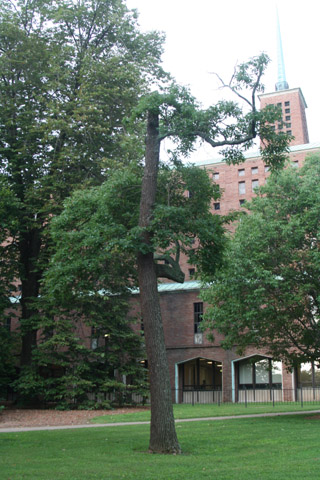
Permanent unique identifier for this particular organism:
http://bioimages.vanderbilt.edu/vanderbilt/6-215
Notes:
This tree is in the middle of the open area between the Divinity School and 21st Ave. S. It's not in very good condition, but it is probably the largest sassafras on campus and therefore provides an opportunity to observe the bark of a large sassafras tree.
One rarely mistakes sassafras for any other tree if its mitten-shaped leaves are present. No other tree has mitten-lobed leaves with smooth margins. Unfortunately, some trees have few or no lobed leaves and their oval leaves look like those of several other species.
Several other characteristics can differentiate sassafras from other trees having leaves with no lobes or teeth. When crushed, the leaves emit an aromatic smell. Spicebush is the other small tree that has aromatic, unlobed leaves. However, spicebush leaves have a pointed tip and spicebush does not have the characteristic green twigs of sassafras. In this area, only box elder has green twigs like this, and box elder has opposite leaves rather than alternate ones like sassafras.
Sassafras fruits are rather odd looking with a single, berry-like structure attached to the end of something that resembles a golf tee. These fruits may be observed on some trees in the fall. The bark of large sassafras trees (such as this one) develop furrowed bark. When chipped, the ridges have a cinnamon color.
One rarely mistakes sassafras for any other tree if its mitten-shaped leaves are present. No other tree has mitten-lobed leaves with smooth margins. Unfortunately, some trees have few or no lobed leaves and their oval leaves look like those of several other species.
Several other characteristics can differentiate sassafras from other trees having leaves with no lobes or teeth. When crushed, the leaves emit an aromatic smell. Spicebush is the other small tree that has aromatic, unlobed leaves. However, spicebush leaves have a pointed tip and spicebush does not have the characteristic green twigs of sassafras. In this area, only box elder has green twigs like this, and box elder has opposite leaves rather than alternate ones like sassafras.
Sassafras fruits are rather odd looking with a single, berry-like structure attached to the end of something that resembles a golf tee. These fruits may be observed on some trees in the fall. The bark of large sassafras trees (such as this one) develop furrowed bark. When chipped, the ridges have a cinnamon color.
 |  |
Load database and switch to thumbnail view
Use this stable URL to link to this page:
http://bioimages.vanderbilt.edu/vanderbilt/6-215.htm
This organism is a living specimen that is part of the Vanderbilt University Arboretum with the local identifier 2-993.
This particular organism is believed to have managedmeans of establishment.
This organismal entity has the scope: multicellular organism.
Remarks:No longer extant in 2024.
Identifications:
Sassafras albidum
(Nutt.) Nees
sec. fna.org 1993
common name: sassafras
family: Lauraceae
Identified 2006-04-06 by Steven J. Baskauf
Location:
Vanderbilt University, Nashville, Davidson County, Tennessee, US
Click on these geocoordinates to load a map showing the location: 36.14657°, -86.80013°
Coordinate uncertainty about: 10 m.
Location of individual determined from GIS database.
Occurrences were recorded for this particular organism on the following dates:
2006-04-06
2014-09-11
The following images document this particular organism.
Click on a thumbnail to view the image and its metadata.Load database and enable navigation by taxon and organism.
| Image | View |
 | whole tree (or vine) - general |
 | inflorescence - whole - female |
 | inflorescence - whole - female |
 | inflorescence - lateral view of flower |
 | inflorescence - frontal view of flower |